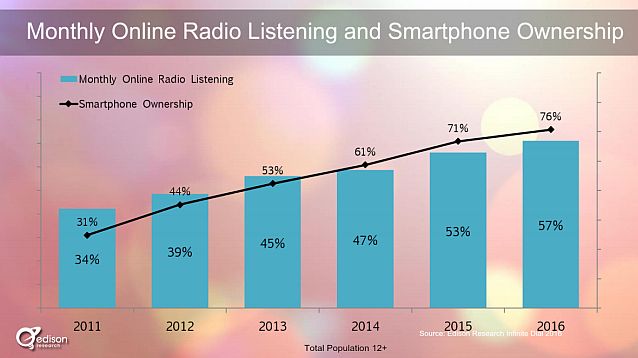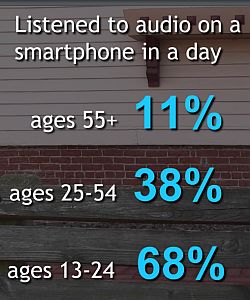The smartphone is one of the most influential consumer electronics categories of the last 20 years. It certainly influences how Americans listen to radio and internet-delivered audio. At RAIN Summit West, Edison Research President Larry Rosin brought new metrics about smartphone listening from Edison’s ongoing Share of Ear and Infinite Dial consumer surveys.
Edison Research estimates that 207-million American teens and adults own a smartphone — that’s 76% percent of the non-child population. As the listening metrics unfold, it’s worth keeping that “reach” in mind, juxtaposed against the much-publicized 93% overall reach of AM/FM reported by Nielsen. In the 12-24 age group, that already high smartphone reach soars to … exactly 93%.
Smartphones and online radio
Infinite Dial also documents how growth of online radio listening correlates to smartphone ownership:

In the Share of Ear work, which canvasses for all sources of listening according to various filters, 19% of time spent listening to all audio is spent on a smartphone. This compares to 51% of time spent listening to all audio is spent on radio receivers. (The Infinite Dial asserts that radio receiver ownership is on the decline — and that is before connected cars become a majority part of the American fleet.)
Move the demographic downward to the 13-34 group, and smartphone listening grows: 35% of time spent listening to all audio is spent on a smartphone.
 Demographics
Demographics
At the RAIN Summit, Larry Rosin explained how dramatic is the demographic influence: when surveyed about listening to audio on smartphones, 11% of the 55+ age group listened to audio on a smartphone on the day they were surveyed, whereas in the 13-24 age group, 68% listened with a smartphone on the day they were surveyed.
This demographic shift is too tectonic to disregard. Over two-thirds of the youngest group, representing the future of mainstream listening, used the phone for listening on the day they were surveyed. The smartphone is overwhelmingly the emergent audio device.
“The smartphone is rapidly becoming the personal entertainment hub,” said Steve Goldstein, Founder & CEO of Amplifi Media. “That’s good for podcasting and streaming. Not so good for linear radio.” Goldstein’s full commentary on the Edison work is here.
Steve Goldstein particularly notes what it is that consumers listen to on the phone. It’s not a lot of traditional radio — only 9% of smartphone audio listening time is with AM/FM. In the 13-34 age group, that number drops to 6%. Most of the rest is owned music (downloads) and streaming music.
The shift
This is where “reach” is threatened, from two directions: device shift, and age shift. The trend logic is unassailable. Smartphone ownership is deeply penetrated. Listening to online radio grows with smartphone ownership. Both these trends are accelerated in younger consumers, who represent the future mainstream.
That’s why, two years ago, at RAIN Summit West 2014, keynote speaker Jason Calacanis held up his phone and intoned, “This is the only thing that matters. This is the only thing that matters. This is the only thing that matters.”
The shift is on.

This sounds to me more of a hardware discussion than a content discussion. Radio companies don’t make radios. The electronics manufacturers make radios. The bad news is the profit margin is much greater in making phones. So they’re not motivated to make cool fun radios that people want to buy, and in fact they’re opposed to incorporating AM/FM radios in phones. As a result, you see what’s happened to radio sales. So as long as radio companies allow the platform to be dictated by someone else, they’ll have to play by someone else’s rules. The best example of that is the music industry and iTunes. They make the product, but iTunes dictates how its sold. Who has the power in that equation? Record labels make more money selling albums. iTunes is built around downloading songs. Who won? Same with radio. As long as radio companies leave the hardware to someone else, they’ll be chasing the audience instead of building the audience.
I have a Tracfone Smartphone. It has an app for FM radio but I don’t listen to it. I prefer my Apple Music app, which I just recently subscribed to, so that I can stream my iTunes library when I’m not at home. I also use my phone’s MP3 player a lot.
Quite right. It’s about the listener having more control over what they want to hear.
On my Smartphone, I listen to this station’s app: heartbeatfm.net
The station is based in Ireland. They play 70’s, 80’s, 90’s lite AC hits. Most songs on the station are well-known to American listeners. A small handful of songs on the station were UK lite AC hits.
I have Pandora Radio’s app on my Smartphone. I listen to a personalized station that I created using some of my favorite soft rock and easy listening songs as seeds.
I prefer my phone’s MP3 player over streaming services. You don’t have to pay a costly subscription every month or every year just to listen to music you like.
At the risk of sounding like a Pollyanna, is it not possible to see this an underdeveloped opportunity for AM/FM radio as opposed to a threat? It seems to me that 9% of all listening on a smartphone is better than what must have been virtually 0% of listening on any other portable device over the past 20 years or so. It’s been a long time since anyone listened to a transistor radio, or radio on a boom box for that matter. Not to mention the growing window for spoken word generated by broadcasr radio talent via podcasts/ on demand audio on mobile devices.
Good points Jeff.
If those 55+ are like my parents, they’re either hesitant about or not interested in newer technology.
I consume radio via TuneIn app on the go, and in my car. Much more radio choice.
I believe that the radio industry should stop getting caught up with belief that putting an FM chip in a handset, will bring them listeners. It won’t. You want listeners, you gotta go to where they are, and that’s online.
But some effort into your website, spend some money on social, and get listed in popular apps like TuneIn, because that is where you’re audience is.
Agreed. The radio industry needs to get with the times.